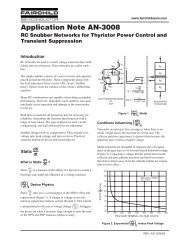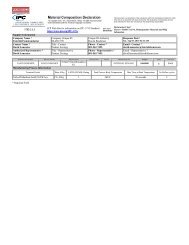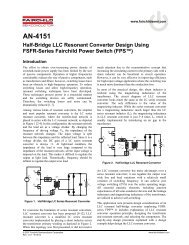Assembly Guidelines for MicroFET™ 1.6x1.6mm Dual Packaging
Assembly Guidelines for MicroFET™ 1.6x1.6mm Dual Packaging
Assembly Guidelines for MicroFET™ 1.6x1.6mm Dual Packaging
You also want an ePaper? Increase the reach of your titles
YUMPU automatically turns print PDFs into web optimized ePapers that Google loves.
AN-9747<br />
<strong>Assembly</strong> <strong>Guidelines</strong> <strong>for</strong> MicroFET <strong>1.6x1.6mm</strong> <strong>Dual</strong><br />
<strong>Packaging</strong><br />
Summary<br />
The Fairchild MicroFET <strong>1.6x1.6mm</strong> is a package based on<br />
Molded Leadless <strong>Packaging</strong> (MLP) technology. This<br />
technology is often used <strong>for</strong> power-related products due to<br />
its low package height and excellent thermal per<strong>for</strong>mance.<br />
Large thermal pads in the center of the package solder<br />
directly to the Printed Wiring Board (PWB). Modularity in<br />
package design, single- and multi-die packages, is within<br />
MLP capability.<br />
The MicroFET 1.6x1.6 has two large die-attach pads,<br />
allowing direct soldering to the PWB <strong>for</strong> best thermal and<br />
electrical per<strong>for</strong>mance. The MicroFET 1.6x1.6 <strong>Dual</strong> is<br />
designed to be used with Fairchild discrete MOSFET<br />
products. This application note focuses on the soldering and<br />
back-end processing of the MicroFET 1.6x1.6 <strong>Dual</strong>.<br />
Board Mounting<br />
The solder joint and pad design are the most important<br />
factors in creating a reliable assembly. The pad dimensions<br />
must allow <strong>for</strong> tolerances in PWB fabrication and pick and<br />
place, which are necessary <strong>for</strong> proper solder fillet <strong>for</strong>mation.<br />
MLP packages, when the pre-plated lead-frame is sawn,<br />
show bare copper on the end of the exposed edge leads. This<br />
is normal and is addressed by IPC JEDEC J-STD-001C<br />
“Bottom Only Termination” standard. In practice, optimized<br />
PWB pad design and a robust solder process often creates<br />
solder fillets to the ends of the lead due to the cleaning<br />
Figure 1. Exposed Copper on Package Edge, Solder<br />
Wetting after Reflow, from Singulation Process<br />
www.fairchildsemi.com<br />
action of the flux in the solder paste. solder fillets to the<br />
ends of the lead due to the cleaning action of the flux in the<br />
solder paste.<br />
PWB Design Considerations<br />
Any land pad pattern must take into account the various<br />
PWB and board assembly tolerances <strong>for</strong> successful<br />
soldering of the MLP to the PWB. These factors are<br />
considered <strong>for</strong> the recommended footprint in the datasheet;<br />
follow this footprint to assure best assembly yield, thermal<br />
per<strong>for</strong>mance, and overall system per<strong>for</strong>mance.<br />
Pad Finish<br />
The MicroFET 1.6x1.6 <strong>Dual</strong> is sold with a lead-free lead<br />
finish. Immersion silver, immersion nickel gold, and<br />
Organic Surface Protectant (OSP), are the pad finishes of<br />
choice <strong>for</strong> lead-free processing. Hot-air solder-level pad<br />
finish does not have chemistry compatibility issues, but is<br />
not recommended due to inconsistency in the thickness of<br />
the finish. Each finish has useful properties and each has<br />
challenges. It is beyond the scope of this paper to debate<br />
each system’s merits. No one finish is right <strong>for</strong> all<br />
applications, but the most common in large-scale consumer<br />
electronics, largely due to cost, is OSP. A high-quality OSP,<br />
<strong>for</strong>mulated <strong>for</strong> the rigors of lead-free reflow, like Enthone ®<br />
Entek ® Plus HT, is recommended.<br />
PWB Material<br />
It is recommended that lead-free FR-4 is used in PWB<br />
construction. Lower-quality FR-4 can cause numerous<br />
problems with the reflow temperatures seen when using<br />
lead-free solder. IPC-4101B “Specification <strong>for</strong> Base<br />
Materials <strong>for</strong> Rigid and Multilayer Printed Boards” contains<br />
further in<strong>for</strong>mation on choosing the correct PWB material<br />
<strong>for</strong> the intended application.<br />
Using Vias with MicroFET 1.6x1.6 <strong>Dual</strong><br />
Designers often wish to place vias inside the thermal pads.<br />
While this is understandable, the vias often create voiding<br />
and appropriately sized vias <strong>for</strong> the small pads can be quite<br />
costly in production. Previous studies have shown the vias<br />
© 2011 Fairchild Semiconductor Corporation www.fairchildsemi.com<br />
Rev. 1.0.1 • 10/31/11
AN-9747 1<br />
can be placed just outside the pad and excellent per<strong>for</strong>mance<br />
still achieved.<br />
Stencil Design<br />
It is estimated that 60% of all assembly errors are due to<br />
paste printing. For a controlled, high-yielding<br />
manufacturing process; it is, there<strong>for</strong>e, the most critical<br />
phase of assembly. Due to the importance of the stencil<br />
design, many stencil types have been characterized to<br />
determine the optimal stencil design <strong>for</strong> the datasheet<br />
recommended footprint pad on a typical application board<br />
with OSP surface finish on FR-4. The paste was printed<br />
from a laser-cut 4-mils thick stainless steel stencil. Two<br />
stencil recommendations are given in the appendix. The best<br />
per<strong>for</strong>mance was found with the split solder print on the<br />
drain tab. However, both solder apertures were proven to<br />
work well. The paste was printed on the outer pins with a<br />
slightly reduced ratio to the PWB pad. IPC-7525 “Stencil<br />
Design <strong>Guidelines</strong>” gives a <strong>for</strong>mula <strong>for</strong> calculating the area<br />
ratio <strong>for</strong> paste release prediction:<br />
Area of Pad<br />
L * W<br />
Area Ratio = =<br />
(1)<br />
Area of Aperture Walls 2 * ( L * W ) * T<br />
where L is the length, W the width, and T the thickness<br />
of the stencil. When using this equation, an area ratio<br />
>0.66 should yield acceptable paste release.<br />
For MicroFET 1.6x1.6 <strong>Dual</strong>, it is recommended that the<br />
solder screen cover 50% of the center pads when using a 4mils<br />
(0.10mm) thick stencil. A drawing is in the appendix,<br />
and can be used as a starting point <strong>for</strong> the solder process<br />
optimization.<br />
Solder Paste<br />
The MicroFET 1.6x1.6 <strong>Dual</strong> is a RoHS-compliant and leadfree<br />
package. The lead finish is NiPdAu. Any standard leadfree<br />
no clean solder paste commonly used in the industry<br />
should work with this package. The IPC Solder Products<br />
Value Council has stated that the lead-free alloy,<br />
96.5Sn/3.0Au/0.5Cu, commonly known as SAC 305, is<br />
“…the lead-free solder paste alloy of choice <strong>for</strong> the<br />
electronics industry.” Type-3 no-clean paste, SAC 305<br />
alloy, was used <strong>for</strong> the construction of the boards studied to<br />
optimize the process.<br />
Figure 2. Printed Solder Paste, Recommended Print<br />
Reflow Profile<br />
The optimum reflow profile used <strong>for</strong> every product and<br />
oven is different. Even the same brand and model oven in a<br />
different facility may require a different profile. The proper<br />
ramp and soak rates are determined by the solder paste<br />
vendor <strong>for</strong> their specific products.<br />
Obtaining this in<strong>for</strong>mation from the paste vendor is highly<br />
recommended. If using a KIC ® profiler, download the latest<br />
paste library from KIC yield ramp rate and soak times at<br />
temperatures <strong>for</strong> most commonly used solder pastes. Using<br />
this data, the software optimizes the zone set-points and<br />
conveyor speed. The Fairchild MicroFET 1.6x1.6 is rated<br />
<strong>for</strong> 260ºC peak temperature reflow. The appendix contains a<br />
sample reflow profile used <strong>for</strong> building demonstration<br />
boards. This profile is provided <strong>for</strong> reference only; different<br />
PWBs, ovens, and pastes changes this profile, perhaps<br />
dramatically.<br />
Voiding<br />
Voiding is a very controversial topic in the industry. The<br />
move to lead-free solders has driven the need <strong>for</strong> intense<br />
study in the area of solders, solder joints, and reliability<br />
effects. There are varying viewpoints on the effect of vias<br />
and allowable quantity. There are several types of voids; <strong>for</strong><br />
simplicity this applications note classifies them into two<br />
categories, macro voids and micro voids.<br />
Macro voids could also be called process voids. Macro<br />
voids are the large-sized voids commonly seen on x-ray<br />
during inspection. These voids are due to process design,<br />
process control issues, or PWB design issues. All of the<br />
parameters discussed in this application note effect macrovoiding.<br />
Most standards that currently exist, such as IPC-<br />
610D, specifically address void criteria <strong>for</strong> BGA and limit it<br />
to 25%. This standard is <strong>for</strong> macro voiding.<br />
There is currently no industry standard <strong>for</strong> macro voiding in<br />
MLP solder joints. Fairchild has completed several<br />
reliability studies, characterizing voiding in various types of<br />
components with large thermal pads and the effect on<br />
reliability. It was found that components with ≤25% voiding<br />
exhibit acceptable reliability per<strong>for</strong>mance in package<br />
© 2011 Fairchild Semiconductor Corporation www.fairchildsemi.com<br />
Rev. 1.0.1 • 10/31/11 2
AN-9747 1<br />
qualification temperature cycling. Fairchild suggests the<br />
25% as maximum voiding <strong>for</strong> MLP type packages.<br />
There are also several <strong>for</strong>ms of micro-voiding, planar micro<br />
voids and Kirkendall voids. The mechanism of void creation<br />
is different <strong>for</strong> each and both are practically undetectable by<br />
x-ray inspection. Both types are also currently the subject of<br />
several in-depth studies; however, none have confirmed<br />
theories of creation.<br />
Planar micro voids, or “champagne voids,” occur at the<br />
PWB land-to-solder-joint interface. There are several<br />
theories on the mechanism that creates planar micro voids,<br />
but there is no industry consensus on the causal mechanism.<br />
Planar micro voids are a risk <strong>for</strong> reliability failures.<br />
Kirkendall voids are created at the interface of two<br />
dissimilar metals at higher temperatures; in the case of<br />
solder attachments, at the pad to joint intermetallic layer.<br />
They are not due to the reflow process; Kirkendall voids are<br />
created by electromigration in assemblies that spend large<br />
amounts of time above 100ºC. There is conflicting evidence<br />
on whether or not Kirkendall voids are a reliability risk.<br />
Figure 3. X-Ray Image Showing Voiding Caused by<br />
Normal Process Variation during Reflow<br />
Rework<br />
Due to the high temperatures associated with lead-free<br />
reflow, it is recommended that this component not be reused<br />
if rework becomes necessary. The MicroFET 1.6x1.6 <strong>Dual</strong><br />
should be removed from the PWB with hot air. After<br />
removal, the MicroFET 1.6x1.6 <strong>Dual</strong> should be discarded.<br />
The solder remnants should be removed from the pad with a<br />
solder vacuum or solder wick, the pads cleaned, and new<br />
paste printed with a mini stencil. Localized hot air can be<br />
applied to reflow the solder and make the joint. Due to the<br />
thermal per<strong>for</strong>mance of this component and the high<br />
per<strong>for</strong>mance PWB it is mounted on, quite a bit of heat<br />
energy is necessary. Heating of the PWB may be helpful <strong>for</strong><br />
the rework process.<br />
Board-Level Reliability<br />
Per JDC-STD-001D, a solder fillet is not required on the<br />
side of the lead <strong>for</strong> this package; but it has been found<br />
through modeling and temperature cycling that a solder<br />
fillet on the lead end can improve reliability. An<br />
improvement of 20% can be expected with this fillet. It has<br />
also been found that the 20% reliability enhancement is<br />
attained even when the fillet only wets halfway up the side<br />
of the lead. Expect to create reliability enhancing solder<br />
fillets through proper process design and control.<br />
As part of the standard reliability testing, this package was<br />
temperature cycled from -40°C to 125°C. There should be<br />
no failures in the sample set at 1000 cycles to pass the test.<br />
© 2011 Fairchild Semiconductor Corporation www.fairchildsemi.com<br />
Rev. 1.0.1 • 10/31/11 3
AN-9747 1<br />
Appendix<br />
Figure 4. Solder Stencil Opening Recommendations (mm)<br />
© 2011 Fairchild Semiconductor Corporation www.fairchildsemi.com<br />
Rev. 1.0.1 • 10/31/11 4
AN-9747 1<br />
Figure 5. Reflow Profile used <strong>for</strong> Building Demonstration Boards<br />
© 2011 Fairchild Semiconductor Corporation www.fairchildsemi.com<br />
Rev. 1.0.1 • 10/31/11 5
AN-9747 1<br />
References<br />
[1] Aspandiar, Raiyo, “Voids in Solder Joints,” SMTA Northwest Chapter Meeting, September 21, 2005, Intel® Corporation.<br />
[2] Bryant, Keith, “Investigating Voids,” Circuits <strong>Assembly</strong>, June 2004.<br />
[3] Comley, David, et al, “The QFN: Smaller, Faster and Less Expensive,” Chip ScaleReview.com, August/September 2002.<br />
[4] Englemaier, Werner, “Voids in Solder Joints-Reliability,” Global SMT & Package, December 2005.<br />
[5] IPC Solder Products Value Council, “Round Robin Testing and Analysis of Lead Free Solder Pastes with Alloys of Tin, Silver<br />
and Copper,” 2005.<br />
[6] IPC-A-610-D, “Acceptance of Electronic Assemblies,” February 2005.<br />
[7] IPC J-STD-001D, “Requirements <strong>for</strong> Soldered Electrical and Electronic Assemblies.”<br />
[8] IPC-SM-7525A, “Stencil Design <strong>Guidelines</strong>,” May 2000.<br />
[9] JEDEC, JESD22-B102D, “Solderability,” VA, Sept. 2004.<br />
[10] Syed, Ahmer, et al, “Board-Level <strong>Assembly</strong> and Reliability Considerations <strong>for</strong> QFN Type Packages,” Amkor Technology, Inc.,<br />
Chandler, AZ.<br />
Related Datasheets<br />
FDFME2P823ZT - http://www.fairchildsemi.com/pf/FD/FDFME2P823ZT.html<br />
FDFME3N311ZT - http://www.fairchildsemi.com/pf/FD/FDFME3N311ZT.html<br />
FDME1023PZT - http://www.fairchildsemi.com/pf/FD/FDME1023PZT.html<br />
FDME1024NZT - http://www.fairchildsemi.com/pf/FD/FDME1024NZT.html<br />
FDME1034CZT - http://www.fairchildsemi.com/pf/FD/FDME1034CZT.html<br />
DISCLAIMER<br />
FAIRCHILD SEMICONDUCTOR RESERVES THE RIGHT TO MAKE CHANGES WITHOUT FURTHER NOTICE TO ANY PRODUCTS<br />
HEREIN TO IMPROVE RELIABILITY, FUNCTION, OR DESIGN. FAIRCHILD DOES NOT ASSUME ANY LIABILITY ARISING OUT OF THE<br />
APPLICATION OR USE OF ANY PRODUCT OR CIRCUIT DESCRIBED HEREIN; NEITHER DOES IT CONVEY ANY LICENSE UNDER ITS<br />
PATENT RIGHTS, NOR THE RIGHTS OF OTHERS.<br />
LIFE SUPPORT POLICY<br />
FAIRCHILD’S PRODUCTS ARE NOT AUTHORIZED FOR USE AS CRITICAL COMPONENTS IN LIFE SUPPORT DEVICES OR SYSTEMS<br />
WITHOUT THE EXPRESS WRITTEN APPROVAL OF THE PRESIDENT OF FAIRCHILD SEMICONDUCTOR CORPORATION.<br />
As used herein:<br />
1. Life support devices or systems are devices or systems<br />
which, (a) are intended <strong>for</strong> surgical implant into the body, or<br />
(b) support or sustain life, or (c) whose failure to per<strong>for</strong>m<br />
when properly used in accordance with instructions <strong>for</strong> use<br />
provided in the labeling, can be reasonably expected to<br />
result in significant injury to the user.<br />
2. A critical component is any component of a life support<br />
device or system whose failure to per<strong>for</strong>m can be reasonably<br />
expected to cause the failure of the life support device or<br />
system, or to affect its safety or effectiveness.<br />
© 2011 Fairchild Semiconductor Corporation www.fairchildsemi.com<br />
Rev. 1.0.1 • 10/31/11 6








